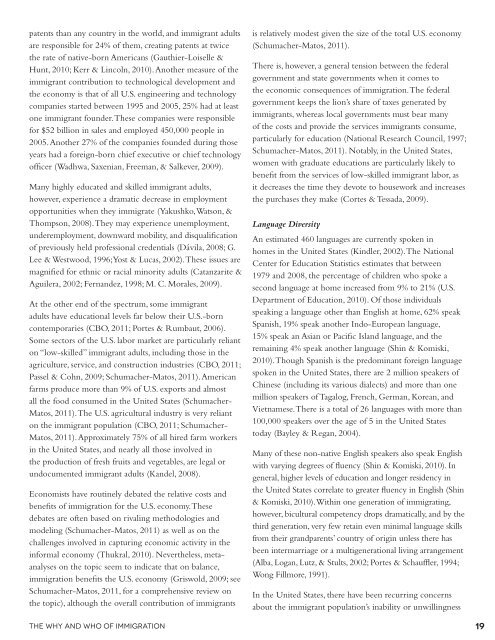Crossroads: The Psychology of Immigration in the New Century
Crossroads: The Psychology of Immigration in the New Century
Crossroads: The Psychology of Immigration in the New Century
Create successful ePaper yourself
Turn your PDF publications into a flip-book with our unique Google optimized e-Paper software.
patents than any country <strong>in</strong> <strong>the</strong> world, and immigrant adults<br />
are responsible for 24% <strong>of</strong> <strong>the</strong>m, creat<strong>in</strong>g patents at twice<br />
<strong>the</strong> rate <strong>of</strong> native-born Americans (Gauthier-Loiselle &<br />
Hunt, 2010; Kerr & L<strong>in</strong>coln, 2010). Ano<strong>the</strong>r measure <strong>of</strong> <strong>the</strong><br />
immigrant contribution to technological development and<br />
<strong>the</strong> economy is that <strong>of</strong> all U.S. eng<strong>in</strong>eer<strong>in</strong>g and technology<br />
companies started between 1995 and 2005, 25% had at least<br />
one immigrant founder. <strong>The</strong>se companies were responsible<br />
for $52 billion <strong>in</strong> sales and employed 450,000 people <strong>in</strong><br />
2005. Ano<strong>the</strong>r 27% <strong>of</strong> <strong>the</strong> companies founded dur<strong>in</strong>g those<br />
years had a foreign-born chief executive or chief technology<br />
<strong>of</strong>ficer (Wadhwa, Saxenian, Freeman, & Salkever, 2009).<br />
Many highly educated and skilled immigrant adults,<br />
however, experience a dramatic decrease <strong>in</strong> employment<br />
opportunities when <strong>the</strong>y immigrate (Yakushko, Watson, &<br />
Thompson, 2008). <strong>The</strong>y may experience unemployment,<br />
underemployment, downward mobility, and disqualification<br />
<strong>of</strong> previously held pr<strong>of</strong>essional credentials (Dávila, 2008; G.<br />
Lee & Westwood, 1996; Yost & Lucas, 2002). <strong>The</strong>se issues are<br />
magnified for ethnic or racial m<strong>in</strong>ority adults (Catanzarite &<br />
Aguilera, 2002; Fernandez, 1998; M. C. Morales, 2009).<br />
At <strong>the</strong> o<strong>the</strong>r end <strong>of</strong> <strong>the</strong> spectrum, some immigrant<br />
adults have educational levels far below <strong>the</strong>ir U.S.-born<br />
contemporaries (CBO, 2011; Portes & Rumbaut, 2006).<br />
Some sectors <strong>of</strong> <strong>the</strong> U.S. labor market are particularly reliant<br />
on “low-skilled” immigrant adults, <strong>in</strong>clud<strong>in</strong>g those <strong>in</strong> <strong>the</strong><br />
agriculture, service, and construction <strong>in</strong>dustries (CBO, 2011;<br />
Passel & Cohn, 2009; Schumacher-Matos, 2011). American<br />
farms produce more than 9% <strong>of</strong> U.S. exports and almost<br />
all <strong>the</strong> food consumed <strong>in</strong> <strong>the</strong> United States (Schumacher-<br />
Matos, 2011). <strong>The</strong> U.S. agricultural <strong>in</strong>dustry is very reliant<br />
on <strong>the</strong> immigrant population (CBO, 2011; Schumacher-<br />
Matos, 2011). Approximately 75% <strong>of</strong> all hired farm workers<br />
<strong>in</strong> <strong>the</strong> United States, and nearly all those <strong>in</strong>volved <strong>in</strong><br />
<strong>the</strong> production <strong>of</strong> fresh fruits and vegetables, are legal or<br />
undocumented immigrant adults (Kandel, 2008).<br />
Economists have rout<strong>in</strong>ely debated <strong>the</strong> relative costs and<br />
benefits <strong>of</strong> immigration for <strong>the</strong> U.S. economy. <strong>The</strong>se<br />
debates are <strong>of</strong>ten based on rival<strong>in</strong>g methodologies and<br />
model<strong>in</strong>g (Schumacher-Matos, 2011) as well as on <strong>the</strong><br />
challenges <strong>in</strong>volved <strong>in</strong> captur<strong>in</strong>g economic activity <strong>in</strong> <strong>the</strong><br />
<strong>in</strong>formal economy (Thukral, 2010). Never<strong>the</strong>less, metaanalyses<br />
on <strong>the</strong> topic seem to <strong>in</strong>dicate that on balance,<br />
immigration benefits <strong>the</strong> U.S. economy (Griswold, 2009; see<br />
Schumacher-Matos, 2011, for a comprehensive review on<br />
<strong>the</strong> topic), although <strong>the</strong> overall contribution <strong>of</strong> immigrants<br />
<strong>The</strong> Why and Who <strong>of</strong> <strong>Immigration</strong><br />
is relatively modest given <strong>the</strong> size <strong>of</strong> <strong>the</strong> total U.S. economy<br />
(Schumacher-Matos, 2011).<br />
<strong>The</strong>re is, however, a general tension between <strong>the</strong> federal<br />
government and state governments when it comes to<br />
<strong>the</strong> economic consequences <strong>of</strong> immigration. <strong>The</strong> federal<br />
government keeps <strong>the</strong> lion’s share <strong>of</strong> taxes generated by<br />
immigrants, whereas local governments must bear many<br />
<strong>of</strong> <strong>the</strong> costs and provide <strong>the</strong> services immigrants consume,<br />
particularly for education (National Research Council, 1997;<br />
Schumacher-Matos, 2011). Notably, <strong>in</strong> <strong>the</strong> United States,<br />
women with graduate educations are particularly likely to<br />
benefit from <strong>the</strong> services <strong>of</strong> low-skilled immigrant labor, as<br />
it decreases <strong>the</strong> time <strong>the</strong>y devote to housework and <strong>in</strong>creases<br />
<strong>the</strong> purchases <strong>the</strong>y make (Cortes & Tessada, 2009).<br />
Language Diversity<br />
An estimated 460 languages are currently spoken <strong>in</strong><br />
homes <strong>in</strong> <strong>the</strong> United States (K<strong>in</strong>dler, 2002). <strong>The</strong> National<br />
Center for Education Statistics estimates that between<br />
1979 and 2008, <strong>the</strong> percentage <strong>of</strong> children who spoke a<br />
second language at home <strong>in</strong>creased from 9% to 21% (U.S.<br />
Department <strong>of</strong> Education, 2010). Of those <strong>in</strong>dividuals<br />
speak<strong>in</strong>g a language o<strong>the</strong>r than English at home, 62% speak<br />
Spanish, 19% speak ano<strong>the</strong>r Indo-European language,<br />
15% speak an Asian or Pacific Island language, and <strong>the</strong><br />
rema<strong>in</strong><strong>in</strong>g 4% speak ano<strong>the</strong>r language (Sh<strong>in</strong> & Komiski,<br />
2010). Though Spanish is <strong>the</strong> predom<strong>in</strong>ant foreign language<br />
spoken <strong>in</strong> <strong>the</strong> United States, <strong>the</strong>re are 2 million speakers <strong>of</strong><br />
Ch<strong>in</strong>ese (<strong>in</strong>clud<strong>in</strong>g its various dialects) and more than one<br />
million speakers <strong>of</strong> Tagalog, French, German, Korean, and<br />
Vietnamese. <strong>The</strong>re is a total <strong>of</strong> 26 languages with more than<br />
100,000 speakers over <strong>the</strong> age <strong>of</strong> 5 <strong>in</strong> <strong>the</strong> United States<br />
today (Bayley & Regan, 2004).<br />
Many <strong>of</strong> <strong>the</strong>se non-native English speakers also speak English<br />
with vary<strong>in</strong>g degrees <strong>of</strong> fluency (Sh<strong>in</strong> & Komiski, 2010). In<br />
general, higher levels <strong>of</strong> education and longer residency <strong>in</strong><br />
<strong>the</strong> United States correlate to greater fluency <strong>in</strong> English (Sh<strong>in</strong><br />
& Komiski, 2010). With<strong>in</strong> one generation <strong>of</strong> immigrat<strong>in</strong>g,<br />
however, bicultural competency drops dramatically, and by <strong>the</strong><br />
third generation, very few reta<strong>in</strong> even m<strong>in</strong>imal language skills<br />
from <strong>the</strong>ir grandparents’ country <strong>of</strong> orig<strong>in</strong> unless <strong>the</strong>re has<br />
been <strong>in</strong>termarriage or a multigenerational liv<strong>in</strong>g arrangement<br />
(Alba, Logan, Lutz, & Stults, 2002; Portes & Schauffler, 1994;<br />
Wong Fillmore, 1991).<br />
In <strong>the</strong> United States, <strong>the</strong>re have been recurr<strong>in</strong>g concerns<br />
about <strong>the</strong> immigrant population’s <strong>in</strong>ability or unwill<strong>in</strong>gness<br />
19
















